Background and context
Diverse geopolitical, market integration and techno-economic dynamics push for further interconnecting the higher voltage systems across countries and continents. The best locations for the generation of renewable electricity are not uniformly distributed across the European continent and worldwide. Sizable renewable energy potential is concentrated in sites far from the power grid (e.g. offshore sea) or where grid transfer capacity is low. The energy production from renewable sources also greatly depends on local weather conditions.
To fully utilise these resources, the power grid must be enhanced to allow electricity to be transported to the main demand and storage centres. A more flexible, yet robust, transmission grid may be instrumental to interlink distant electricity markets and take advantage of the low-carbon resources temporal and spatial complementarity. All the above may drive the realisation of a transcontinental higher transfer capacity system to transport large amounts of electricity over long distances. High Voltage Direct Current (HVDC) technologies, due to their lower losses and smaller environmental impact, promise to be the cornerstones of such global power grid.
Our role
We assess building blocks and progress towards the development and interconnection of the European electricity transmission grid. More in detail, we conduct research on:
- the feasibility and sustainability of alternative options to interlink neighbouring continent's power grids.
- the geopolitical dynamics driving the transcontinental grid developments.
- the technological progress towards higher transfer capacity architectures.
- the techno-economic challenges for redesigning the trans-European electricity networks.
- the impacts on power exchanges of more strongly interconnected extra high voltage grids.
Main publications
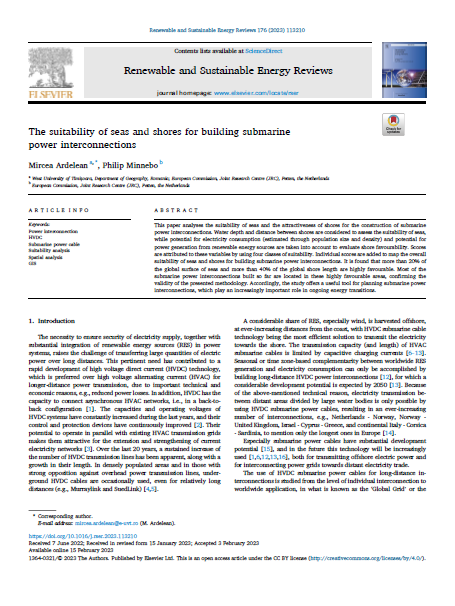
2023 - The suitability of seas and shores for building submarine power interconnections
This paper analyses the suitability of seas and the attractiveness of shores for the construction of submarine power interconnections. Water depth and distance between shores are considered to assess the suitability of seas, while potential for electricity consumption (estimated through population size and density) and potential for power generation from renewable energy sources are taken into account to evaluate shore favourability. Scores are attributed to these variables by using four classes of suitability. Individual scores are added to map the overall suitability of seas and shores for building submarine power interconnections. It is found that more than 20% of the global surface of seas and more than 40% of the global shore length are highly favourable. Most of the submarine power interconnections built so far are located in these highly favourable areas, confirming the validity of the presented methodology. Accordingly, the study offers a useful tool for planning submarine power interconnections, which play an increasingly important role in ongoing energy transitions.
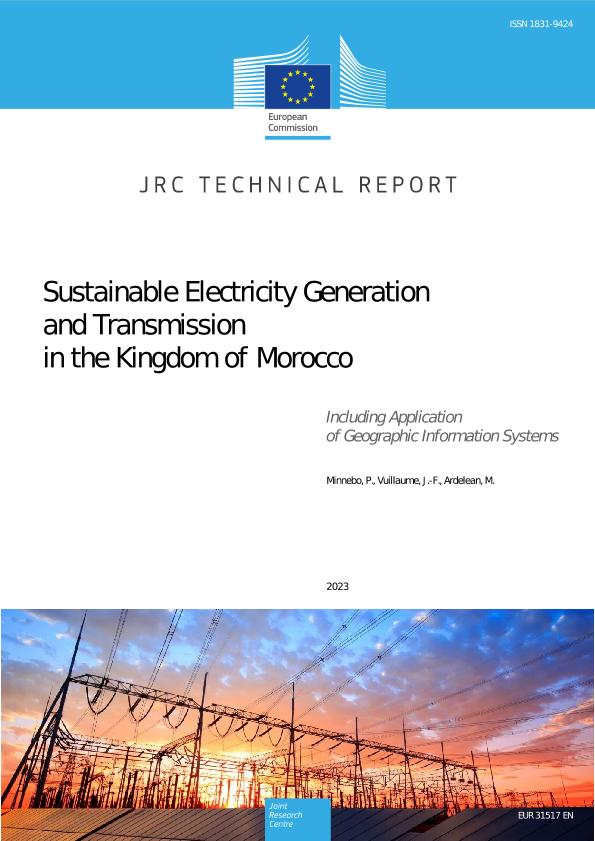
2023 - Sustainable electricity generation and transmission in the Kingdom of Morocco
This technical report presents a concise assessment of the Moroccan power system, in relation to the country’s pursued clean energy transition. It provides an introduction into the most critical factors affecting this transition, both technical and regulatory, with focus on development of generation and transmission assets of clean electricity. Morocco’s general energy and climate change characteristics are discussed, giving emphasis to related engagement and international collaboration. The legal framework of the Moroccan power sector is addressed, along with basic data on electricity demand, generation and transmission. Sources for more sustainable electricity generation are discussed, i.e., primarily renewable energy (solar, wind and hydro), as well as natural gas in the energy transition, and the option of nuclear energy. Past, ongoing and future transmission system development programmes are treated. As a scientific application, the role of geographic information systems in the planning phase of power generation and transmission installations is considered. Future investment needs are highlighted, along with the most pertinent funding organisations.
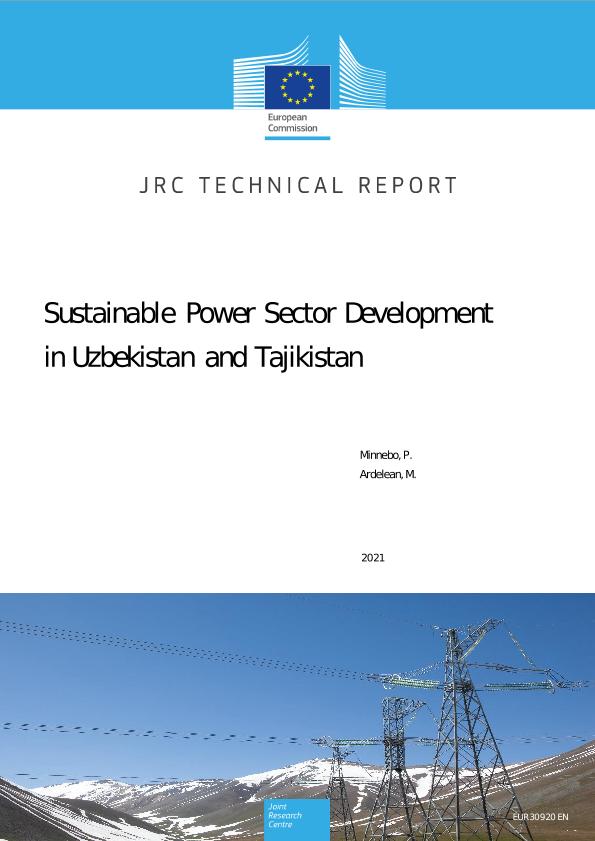
2021 - Sustainable Power Sector Development in Uzbekistan and Tajikistan
Sustainable development of the Uzbek and Tajik power sectors offers attractive opportunities for both countries, i.e. in terms of improved security of electricity supply and increased use of renewable energy sources, along with reduced greenhouse gas emissions and air pollution. Moreover, potential economic benefits arise from enhanced bilateral electricity trade. This report summarises the critical factors, affecting the envisaged development. The present status of the power sectors is discussed, including generation and consumption characteristics, and legal frameworks. Technical deficiencies are addressed, together with anticipating legislation, fostering modernisation of power system assets. Renewable energy potential in both countries is considered, with focus on hydro, solar and wind energy. Policies towards increased use of this potential are presented. Emphasis is given to ongoing and planned investments in electricity generation and transmission infrastructures, towards efficient and clean power systems, and enhanced electricity trade between both countries.
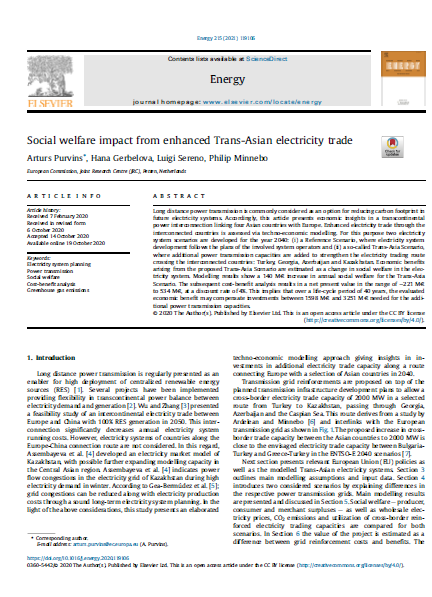
2018 - Social welfare impact from enhanced Trans-Asian electricity trade
This article presents economic insights in a transcontinental power interconnection linking four Asian countries with Europe. Enhanced electricity trade through the interconnected countries is assessed via techno-economic modelling. Economic benefits arising from the proposed Trans-Asia Scenario are estimated as a change in social welfare in the electricity system. Modelling results show a 140 MV increase in annual social welfare for the Trans-Asia Scenario. The subsequent cost-benefit analysis results in a net present value in the range of 221 M€ to 534 M€, at a discount rate of 4%. This implies that over a life-cycle period of 40 years, the evaluated economic benefit may compensate investments between 1598 MV and 3251 MV needed for the additional power transmission capacities.
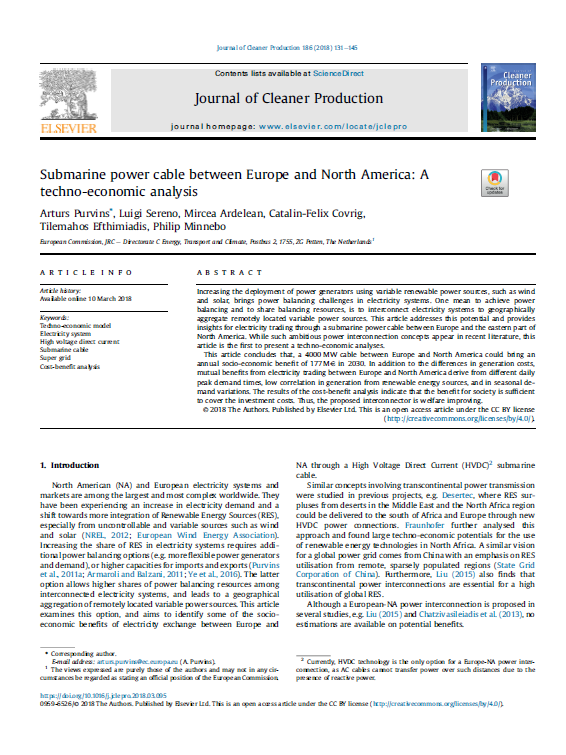
2018 - Submarine power cable between Europe and North America: A techno-economic analysis
Increasing the deployment of power generators using variable renewable power sources, such as wind and solar, brings power balancing challenges in electricity systems. One mean to achieve power balancing and to share balancing resources, is to interconnect electricity systems to geographically aggregate remotely located variable power sources. This article addresses this potential and provides insights for electricity trading through a submarine power cable between Europe and the eastern part of North America. While such ambitious power interconnection concepts appear in recent literature, this article is the first to present a techno-economic analyses. This article concludes that, a 4000 MW cable between Europe and North America could bring an annual socio-economic benefit of 177 M€ in 2030. In addition to the differences in generation costs, mutual benefits from electricity trading between Europe and North America derive from different daily peak demand times, low correlation in generation from renewable energy sources, and in seasonal demand variations. The results of the cost-benefit analysis indicate that the benefit for society is sufficient to cover the investment costs. Thus, the proposed interconnector is welfare improving.
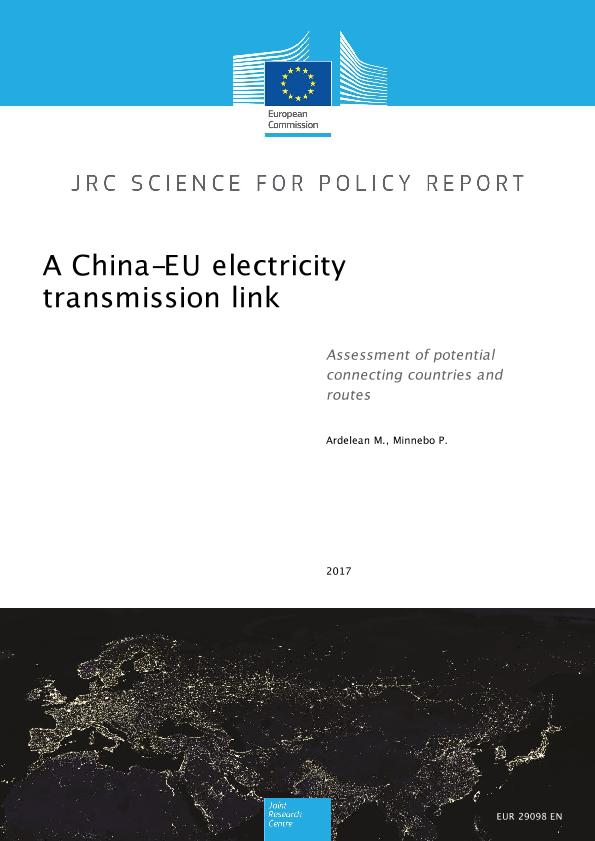
2017 - A China-EU electricity transmission link: Assessment of potential connecting countries and routes
The report looks at the potential routes for a future power interconnection between EU and China. High voltage direct current technology is considered and its potential is assessed. It analyses the renewable energy sources in the countries along the potential routes as well as the power sector and power grid in the countries crossed. Three potential routes are analysed.
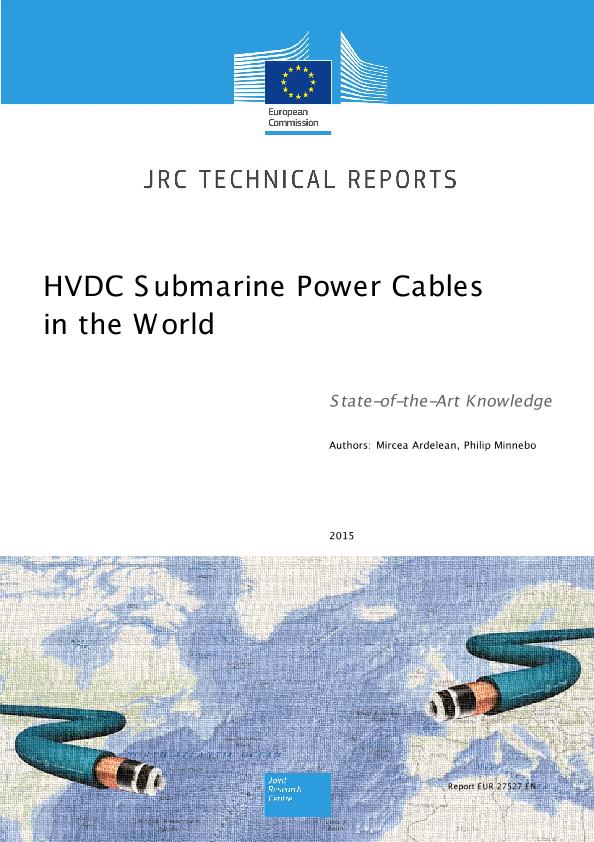
2015 - HVDC Submarine Power Cables in the World: State-of-the-Art Knowledge
This report is the first deliverable of the OTG ("Offshore Transnational Grid") Work Package (2015-2016), which is intended to identify and analyse the engineering and geopolitical challenges for realising a transcontinental energy interconnection between Europe and North America. The paper first of all addresses the principles of a High Voltage Direct Current (HVDC) power transmission system. Special attention is given to submarine cable interconnections. The spatial context of these cables is discussed. The used technologies and materials are addressed as well as the methods used to install and operate the cables. Additional aspects, such as safety and environmental issues, are also discussed. Further the report gives an overview of operational and planned HVDC submarine power cable systems. An extensive inventory list of these cables is annexed. Finally a set of conclusions are put forward, primarily pointing at further actions of the Work Package.
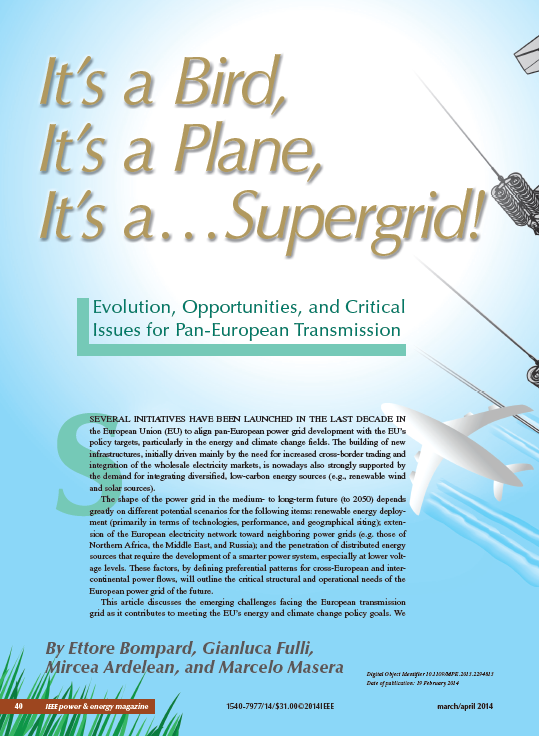
2014 - It's a Bird, It's a Plane, It's a...Supergrid!: Evolution, Opportunities, and Critical Issues for Pan-European Transmission
Several initiatives have been launched in the last decade in the European Union (EU) to align pan-European power grid development with the EU?s policy targets, particularly in the energy and climate change fields. The building of new infrastructures, initially driven mainly by the need for increased cross-border trading and integration of the wholesale electricity markets, is nowadays also strongly supported by the demand for integrating diversified, low-carbon energy sources (e.g., renewable wind and solar sources).
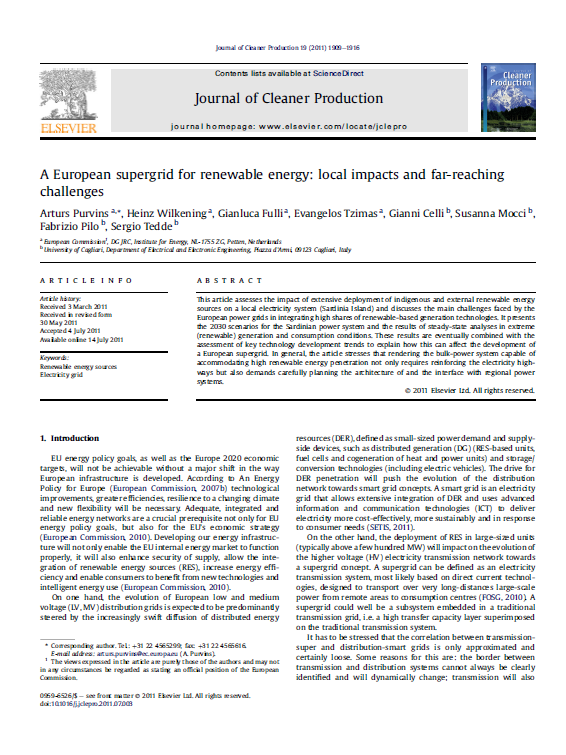
2011 - A European supergrid for renewable energy: local impacts and far-reaching challenges
This article assesses the impact of extensive deployment of indigenous and external renewable energy sources on a local electricity system and discusses the main challenges faced by the European power grids in integrating high shares of renewable-based generation technologies. It presents the 2030 scenarios for the Sardinian power system and the results of steady-state analyses in extreme (renewable) generation and consumption conditions. These results are eventually combined with the assessment of key technology development trends to explain how this can affect the development of a European supergrid. In general, the article stresses that rendering the bulk-power system capable of accommodating high renewable energy penetration not only requires reinforcing the electricity highways but also demands carefully planning the architecture of and the interface with regional power systems.
